1lumen selects and reviews products personally. We may earn affiliate commissions through our links, which help support our testing.
Skilhunt H300 review
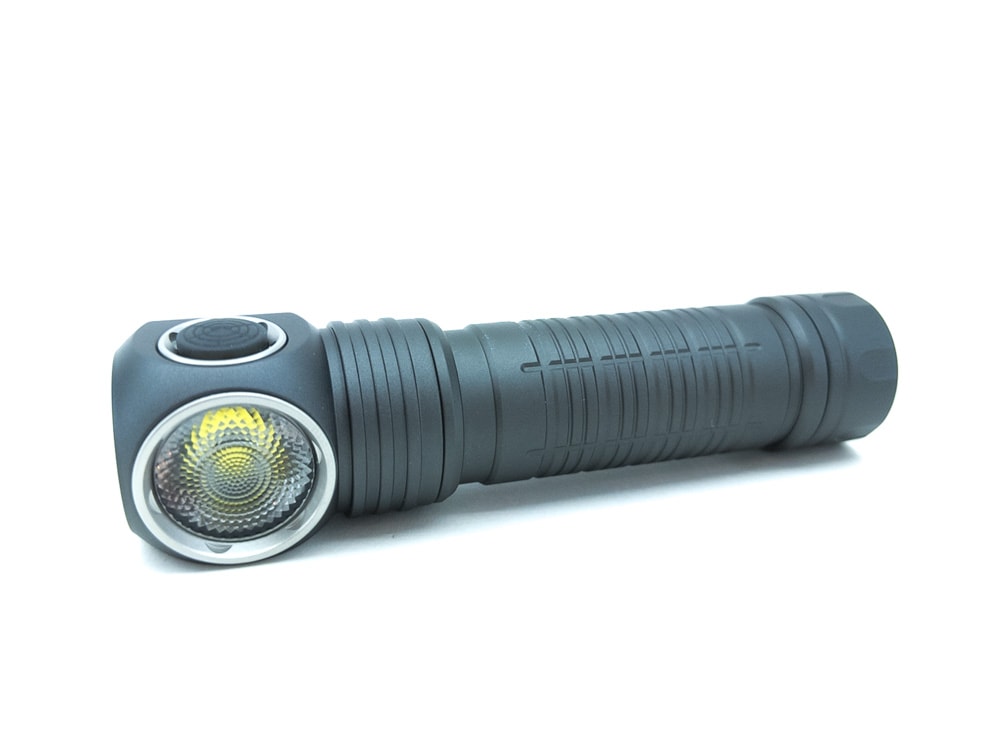
Skilhunt H300 specifications
| Brand/model | Skilhunt H300 |
|---|---|
| Category | Best headlamps |
| LED | CREE XHP50.2 |
| Lumens | 2,200 lm |
| Beam intensity | 5,000 cd |
| Battery config. | 1*18650 |
| Material | Aluminum |
| Modes | 7 |
| Blinkies | Strobe / SOS / Beacon |
| Reflector | TIR or OP reflector |
| Waterproof | IPX8 |
| Review date | October 2021 |
Introduction:
I’ve had the pleasure of owning a few Skilhunt products over the past few years, mainly some of their smaller flashlights: the M150, the E3A, and the E2A. The E2A and E3A were rather simple but very well executed. The M150 however… what a sweet little AA/14500 light! Over the past several years, though, I’ve always seen Skilhunt headlamps (the H03 and H04) recommended more than almost any other headlamp. I’ve never checked out a Skilhunt headlamp before today though. And here Skilhunt is with a new model: the H300. I’m anxious to see what makes Skilhunt’s headlamps special. If they’re anything like the flashlights I’ve had, I know good things are in store.
Note: we also reviewed the Skilhunt H300 Nichia 144ART version.
Package quality.
The Skilhunt H300 arrived in a fairly standard box. It would look right at home on a store shelf: rack hanging point, product viewing window, and eye-catching yellow and black color scheme. Unlike many lights, the package doesn’t bore (or woo?) you with all sorts of specs. The lumen rating is the only spec mentioned. Rather, the box focuses on the features and use-cases of the headlamp. That’s a nice departure from the norm. Inside this box was:
- Skilhunt H300 headlamp
- Skilhunt BL-131 18650 battery
- Magnetic charging cable MC-20
- Spare o-rings
- Lanyard
- Pocket clip
- Head strap & bracket
- Rubber pad (more on that later)
- Manual
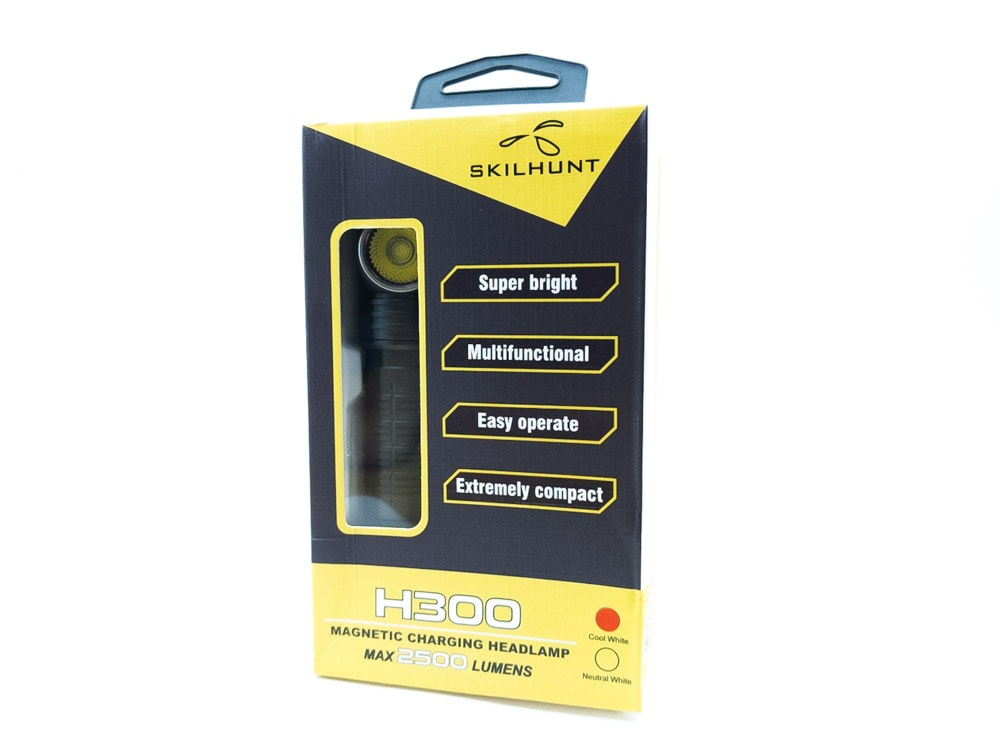
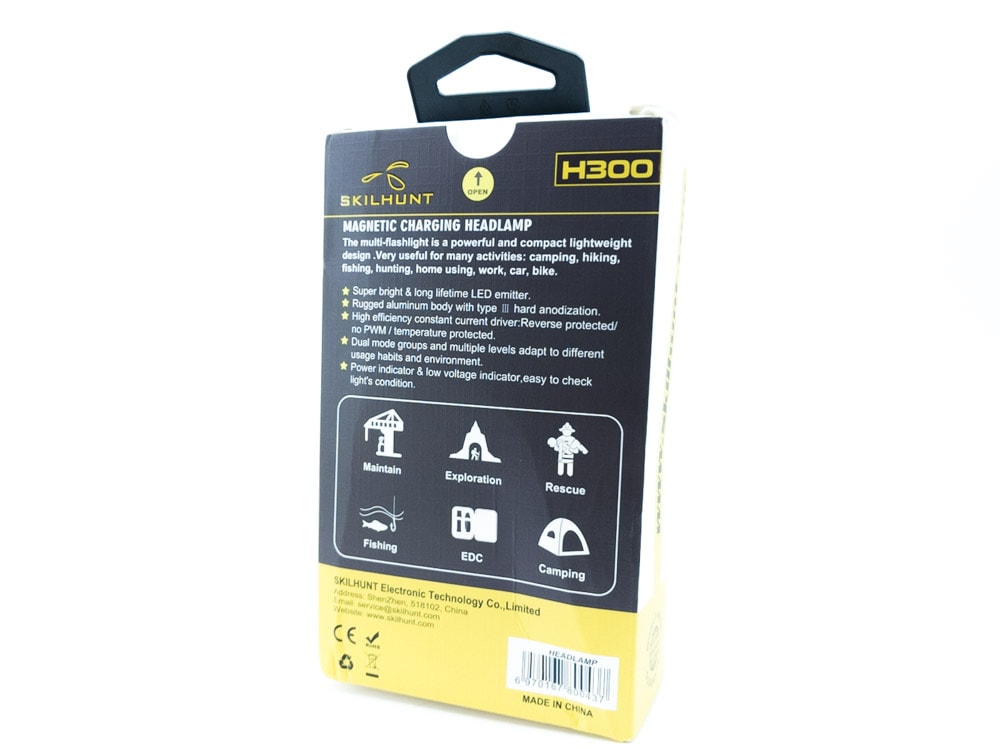
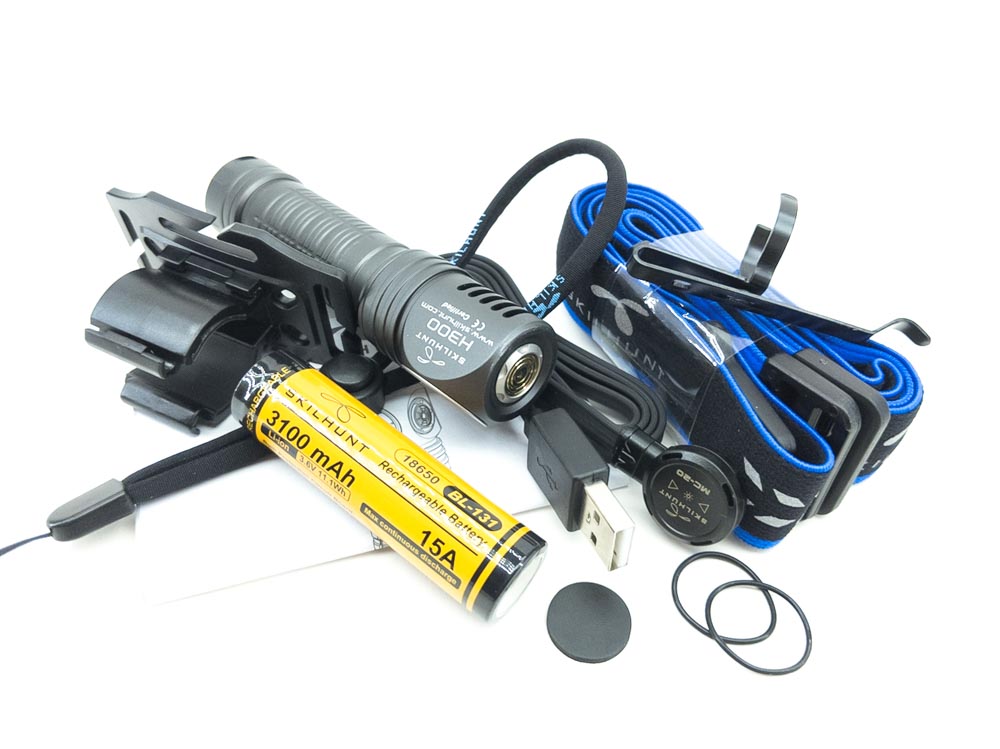
Flashlight in use
Portable headlamps come in two main configurations: L-shaped and T-shaped. With T-shaped headlamps, the LED is in the center and can feel a bit more natural as you look around, a definite plus. But L-shaped headlamps, whose LED is at the end of the body, have a different advantage: they frequently can be removed from their holder and used as a right-angle work light. Such is the case with the Skilhunt H300 – it can quickly be detached from the headstrap mount and be used independently.
A first for me, the headstrap actually comes in 3 pieces Ikea style: some assembly required. It’s not rocket science, but putting the band together with the bracket isn’t exactly intuitive, nor are there instructions for doing so. Once you do get it together, it works quite well. There’s a grippy strip that runs the entire interior of the band that helps keep the strap on your head (or helmet). And if you prefer an around-the-head band as opposed to the over-the-head style, you can easily make that happen.
The Skilhunt H300 comes with a standard lanyard that attaches through a couple of discrete holes in the tailcap. It also ships with a pretty sturdy pocket clip. As if all of those options weren’t enough (strap, lanyard, clip), Skilhunt provides another way of using the H300: a magnetic tailcap. Yup, Skilhunt ships this with a magnet loaded up in the tailcap, aiding you to position it in all sorts of useful ways: under a car hood, on an appliance, etc. Some people prefer not to have a magnet, and fear not: Skilhunt has you covered too! The H300 ships with a little rubber disc that can be swapped in lieu of the magnet.
The Skilhunt H300 has a single electronic switch that’s situated on the side of the head. This is my personal preferred location for headlamps, as it allows you to reach up and pinch the lamp to activate the switch. That seems more natural to me than those that have a button on the end, forcing you to push the headlamp around.

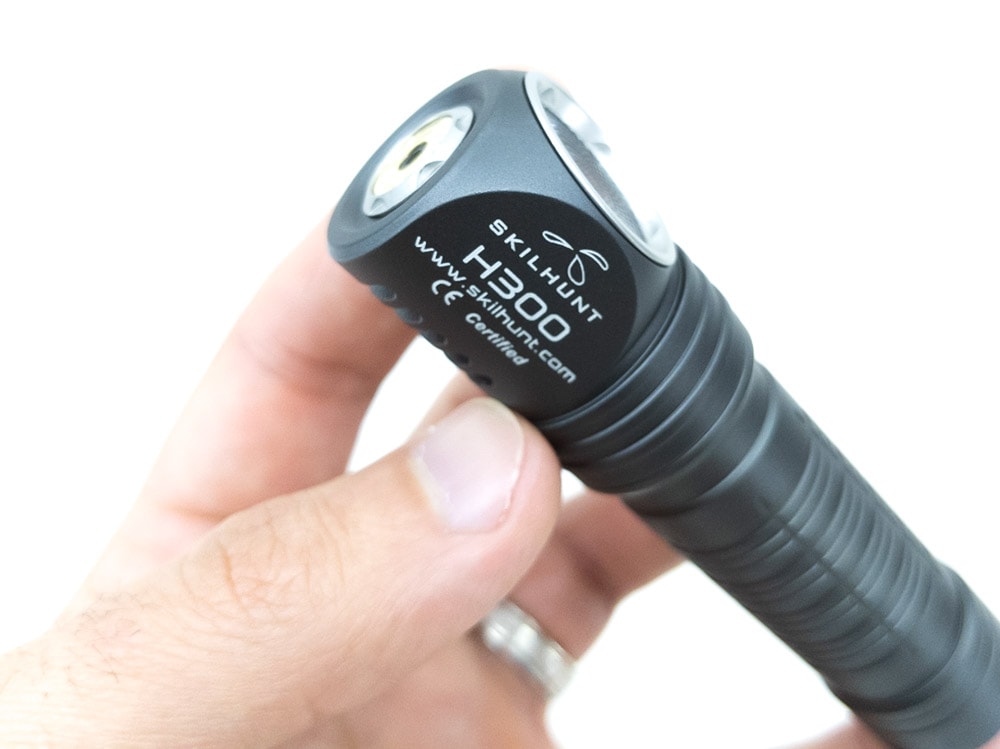

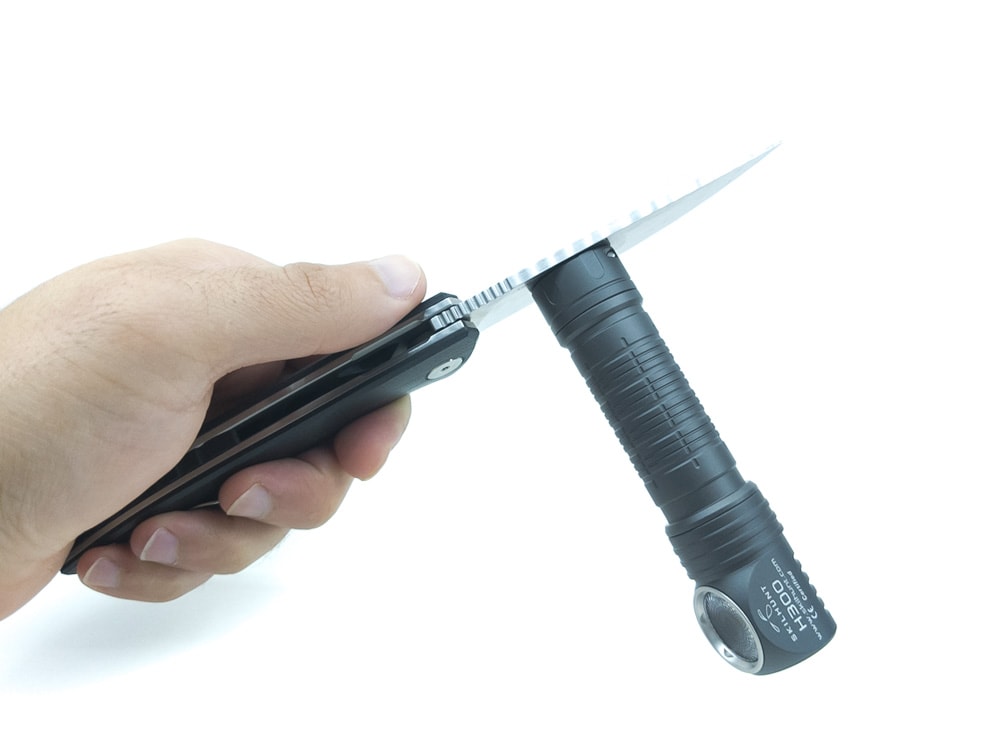
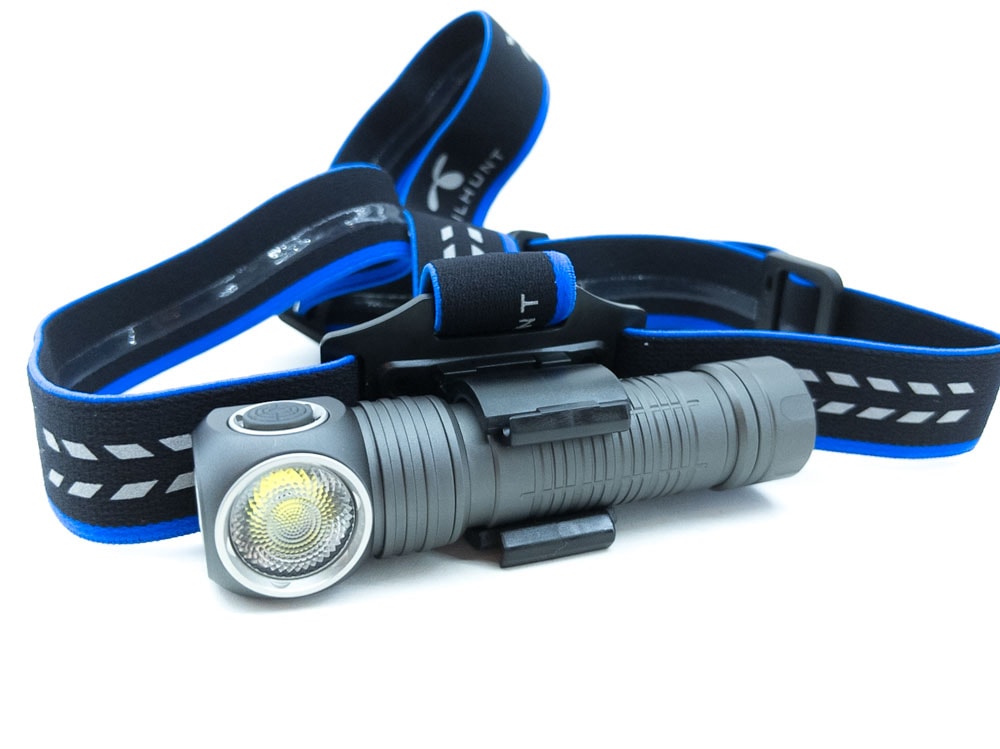
Build Quality, and Warranty
When it comes to anodizing and overall fit & finish, Skilhunt brings a good game. All of my Skilhunt lights have felt well executed. The H300 follows this pattern with its hard-anodized type III coating. As far as I could see, Skilhunt doesn’t mention if HA III is only for the Carbon Black model, or if that is also true of the Metal Gray that I received. Either way, the anodizing looks and feels great: a nice, medium matte. Very even and consistent.
The anodized aluminum body is accentuated with what appears to be stainless bezels around the switch, optic, and charging pad. These add a nice, sophisticated look.
There isn’t any knurling, per se, but the body does feature a set of grooves and channels that help provide some grip. The body tube appears to be glued to the head. The tailcap threads are anodized and smooth.
Skilhunt’s Warranty Policy:
- Within 15 days of purchase, free replacement due to manufacturing defects
- Within 24 months, free repairs
- For the lifetime of the product, Skilhunt will provide warranty service. They will cover the labor, the buyer is responsible for the cost of the parts.
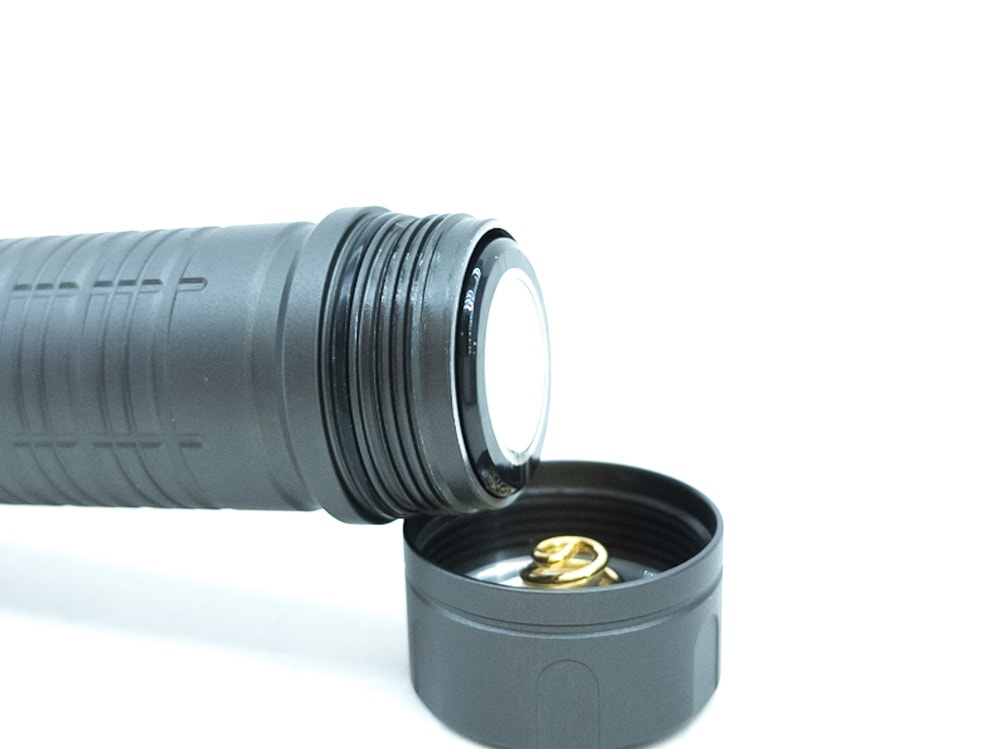
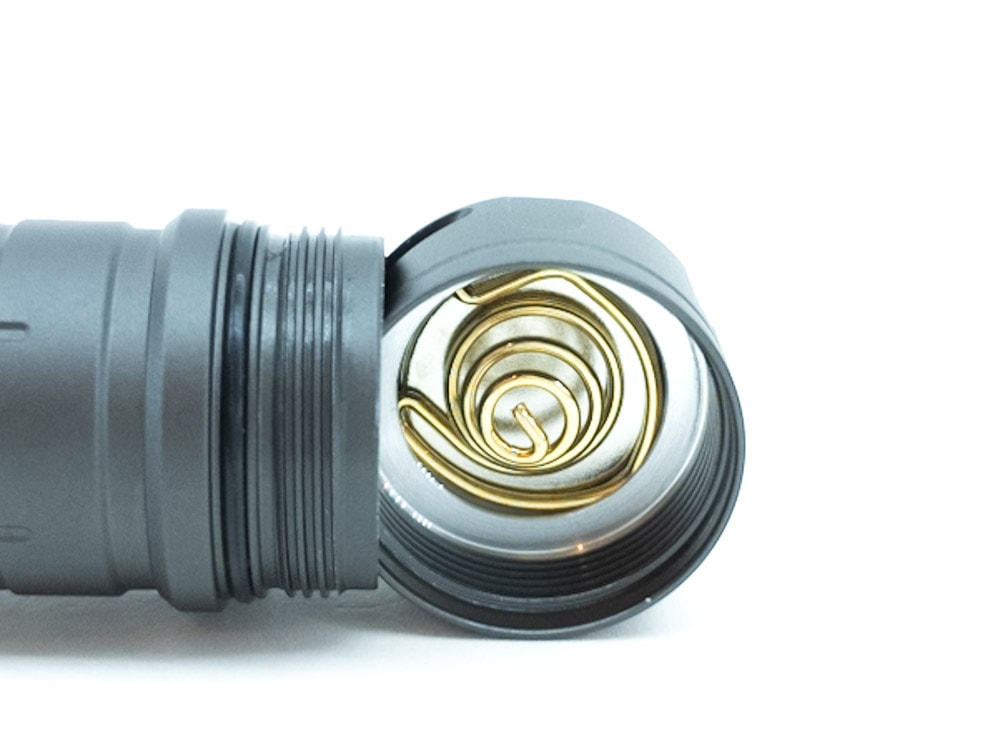

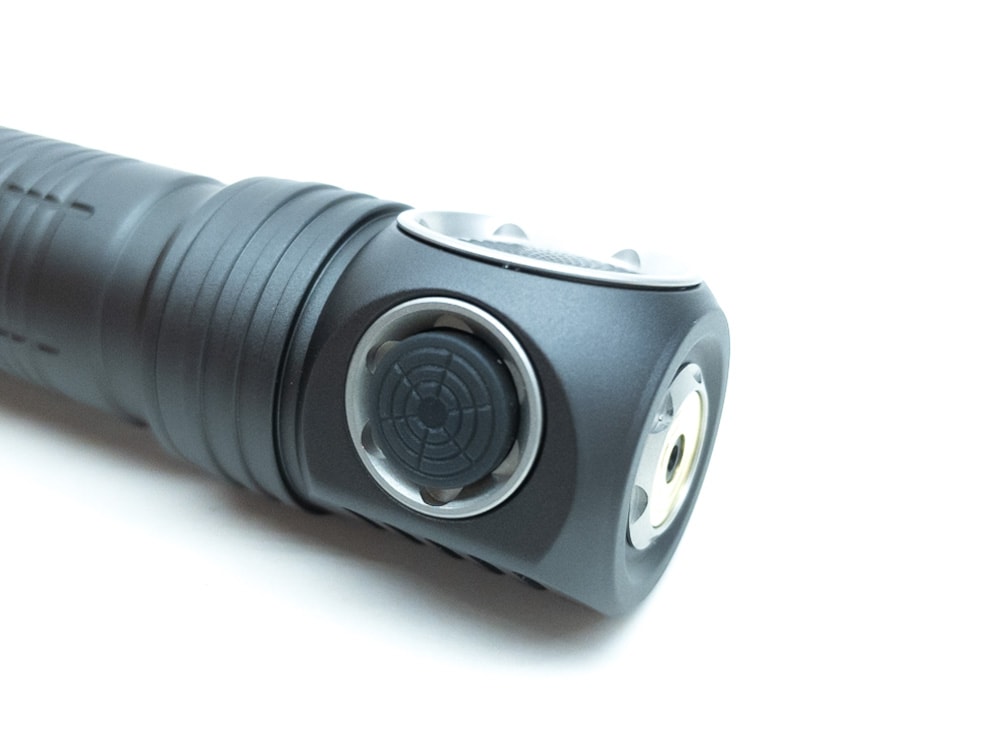
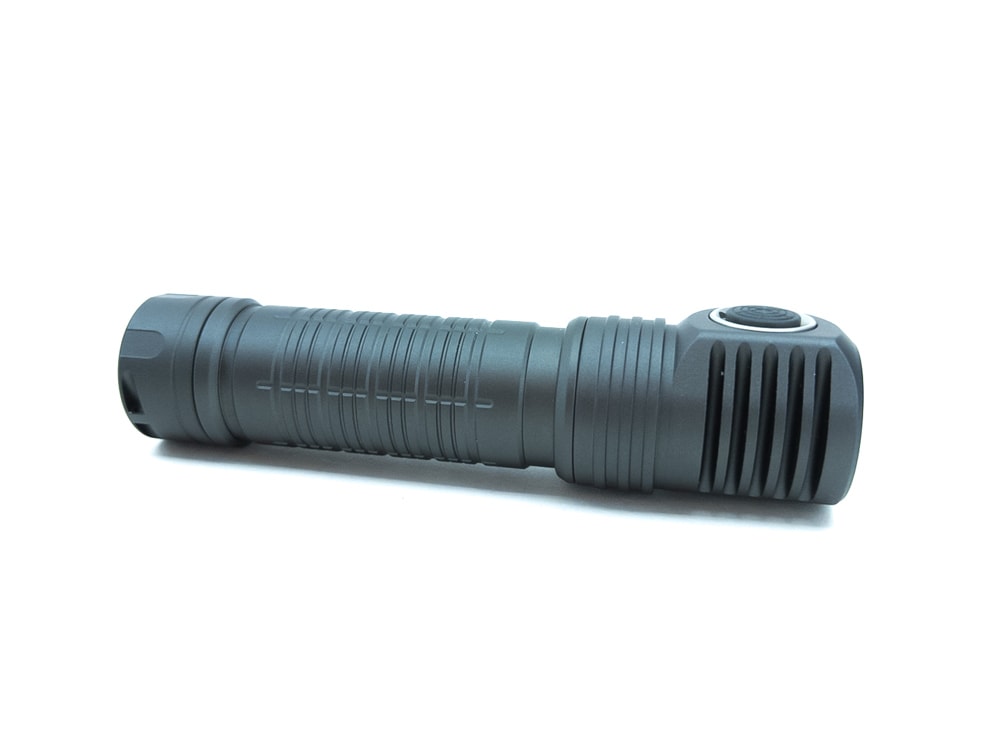
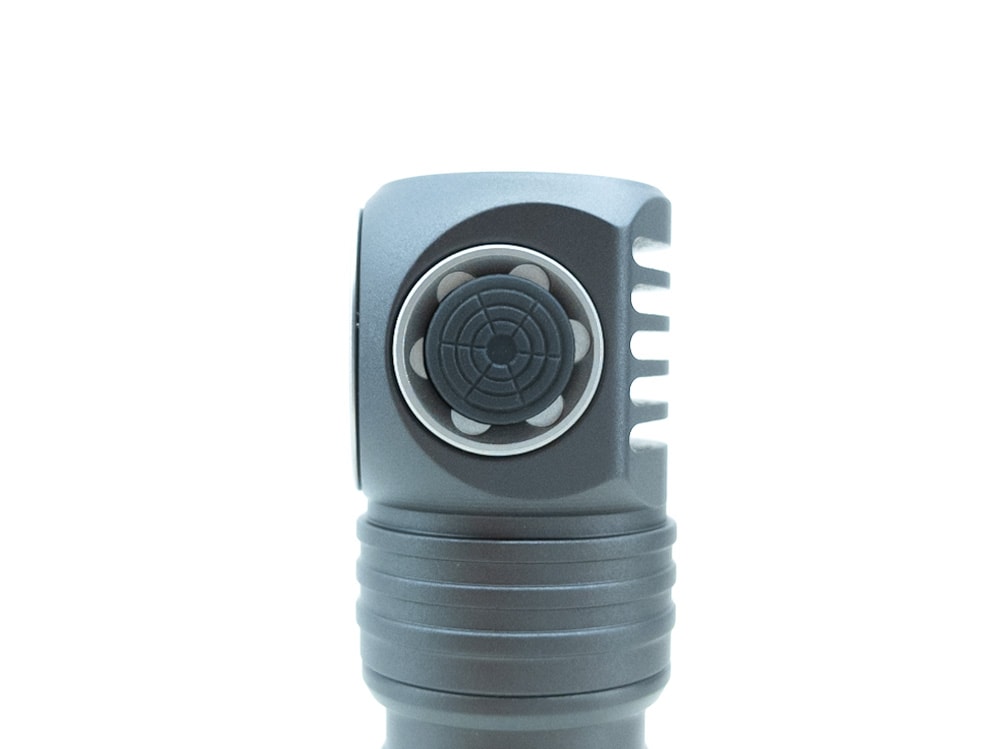
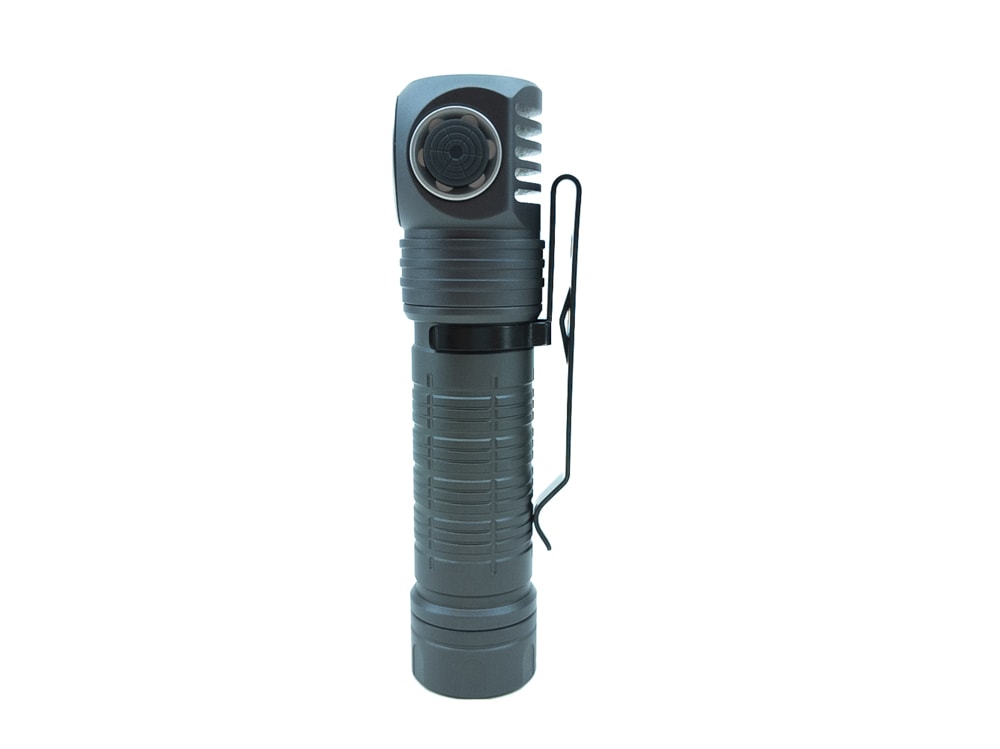
LED, Lens, Bezel, and Reflector
The Skilhunt H300 comes outfitted with a Cree XHP50.2 LED. You get your choice of Cool White (6500K) or Neutral White (5000K) LEDs. The sample in my possession is the Cool White version.
Newer Cree LEDs like the XHP50.2 are a bit infamous for their ugly tint shift. So I was a bit worried about having one in a headlamp. Skilhunt, however, equipped the H300 with a beautiful textured TIR optic for a “smooth and balanced beam”. And it does a good job of that. I can just barely see some tint shift if I’m really looking for it against white walls. I would not say that it’s noticeable or distracting, much better than pretty much any light I’ve seen with an XHP in it. Good choice on that very nice optic, Skilhunt.
Now the H300 does have a sibling: the H300R. The “R” is for reflector. It should essentially be the same light, just with an orange peel reflector instead of the TIR. Going this route picks up a marginal amount of throw, if that’s your preference for a headlamp. But I would be wary of this option as I’m sure the tint shift would be more noticeable in the reflector.
A couple last bits about the TIR… it’s pretty good sized. It’s easily larger than the reflector (or the optic I replace it with) in the Convoy H1. It’s much bigger than what you’d find on something like the Wuben H1 or Nitecore HC60 V2. Lastly, the TIR is not protected by glass. So if you’re one to be rough with your things, you might spare some caution.
I measured the LED with my Opple Light Master Pro and got the following figures:
- CCT: 6960K
- CRI: 73
- Duv: -0.0006
So… definitely Cool White, and a bit cooler than what Skilhunt listed (6500K), though every LED bin has some deviation.

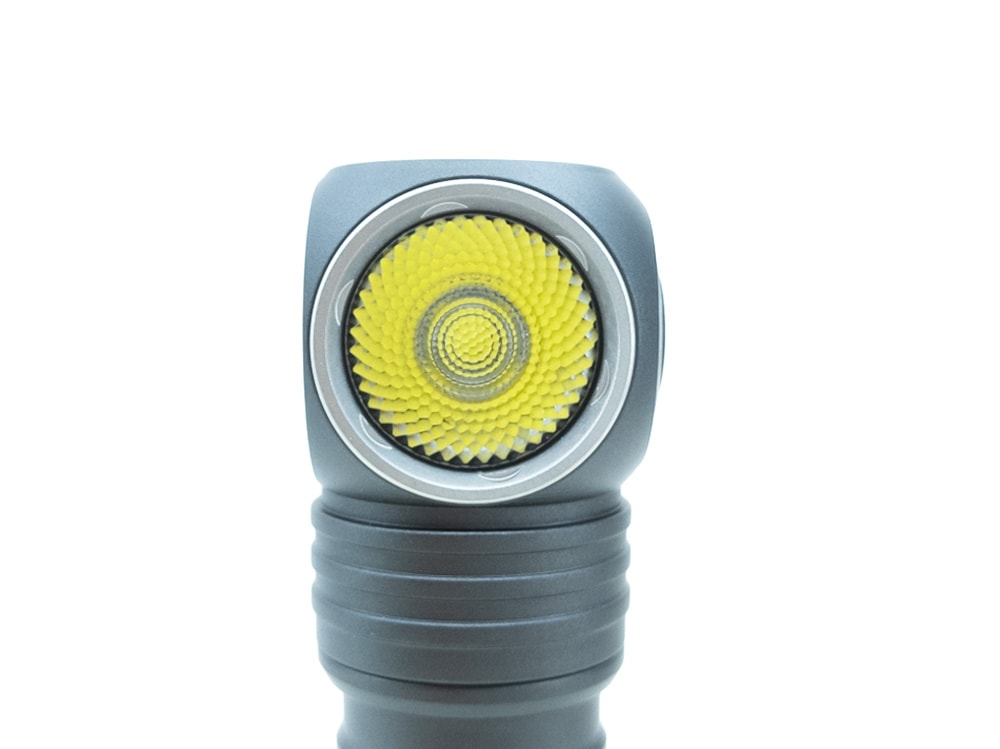
Dimensions and size comparison
- Length: 104.7 mm / 4.12 inches
- Head diameter: 25.2 mm / 0.99 inches
- Body diameter: 21.6 mm / 0.85 inches
Weight:
- Without cells: 54 grams / 1.9 oz.
- With cells: 102 grams / 3.6 oz.
Flashlight and headlamp comparison
L-shaped headlamps, from left to right: Skilhunt H300, Convoy H1
With T-shaped headlamps, left to right: Nitecore HC60 V2, Skilhunt H300, Wuben H1
With common flashlights, left to right: Wurkkos FC11, Skilhunt H300, Reylight TI LAN, Sofirn SP10S
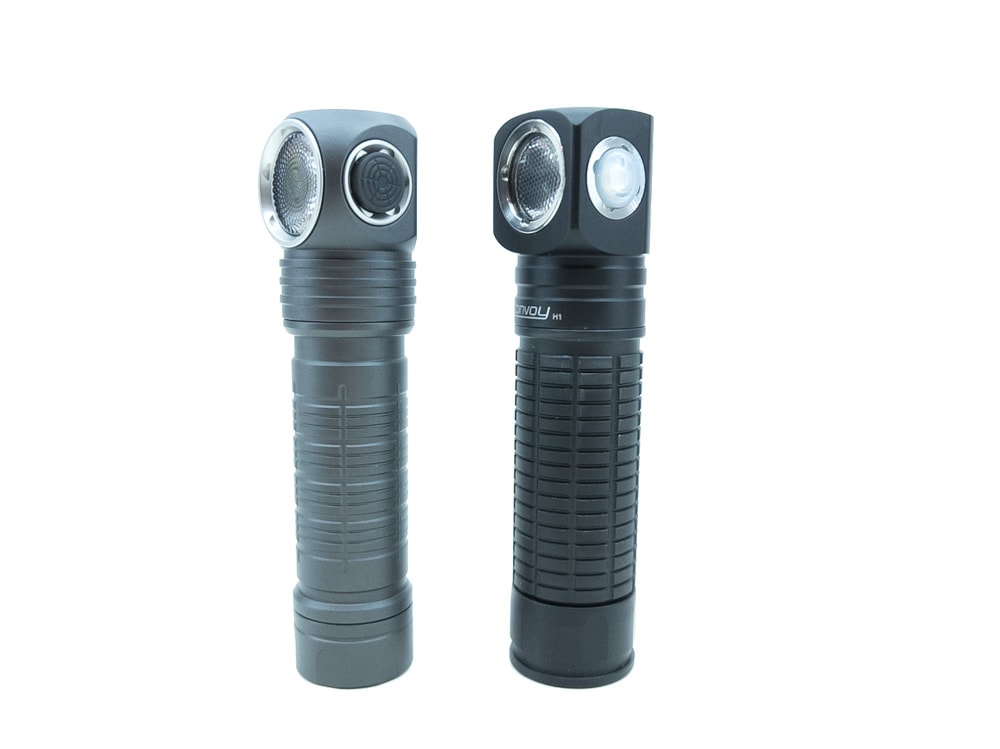
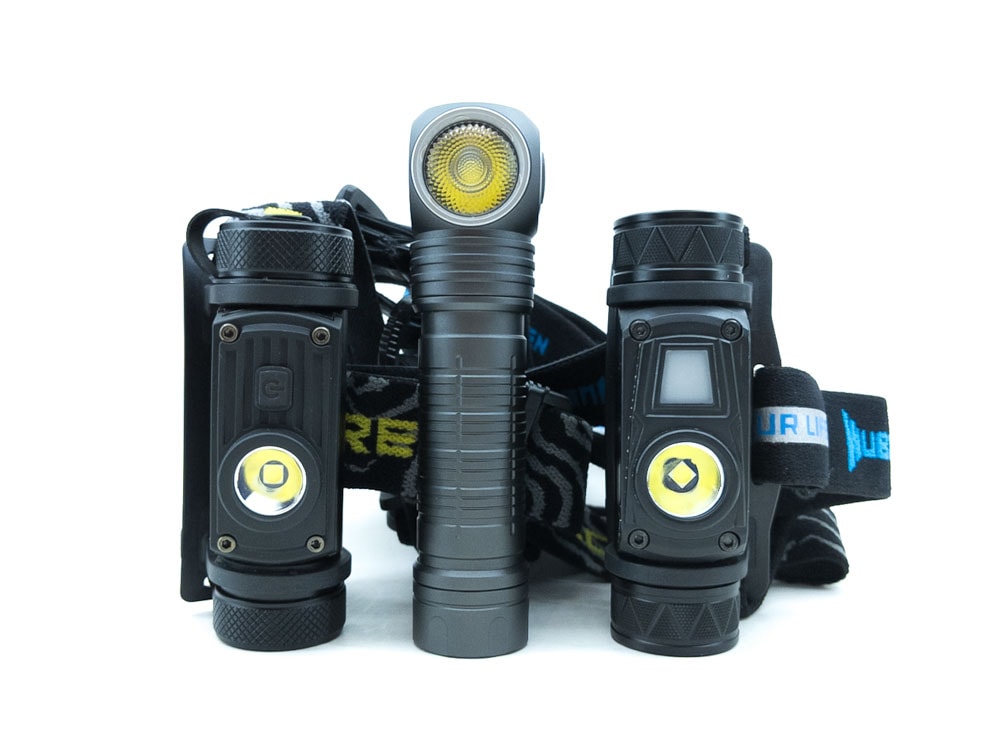
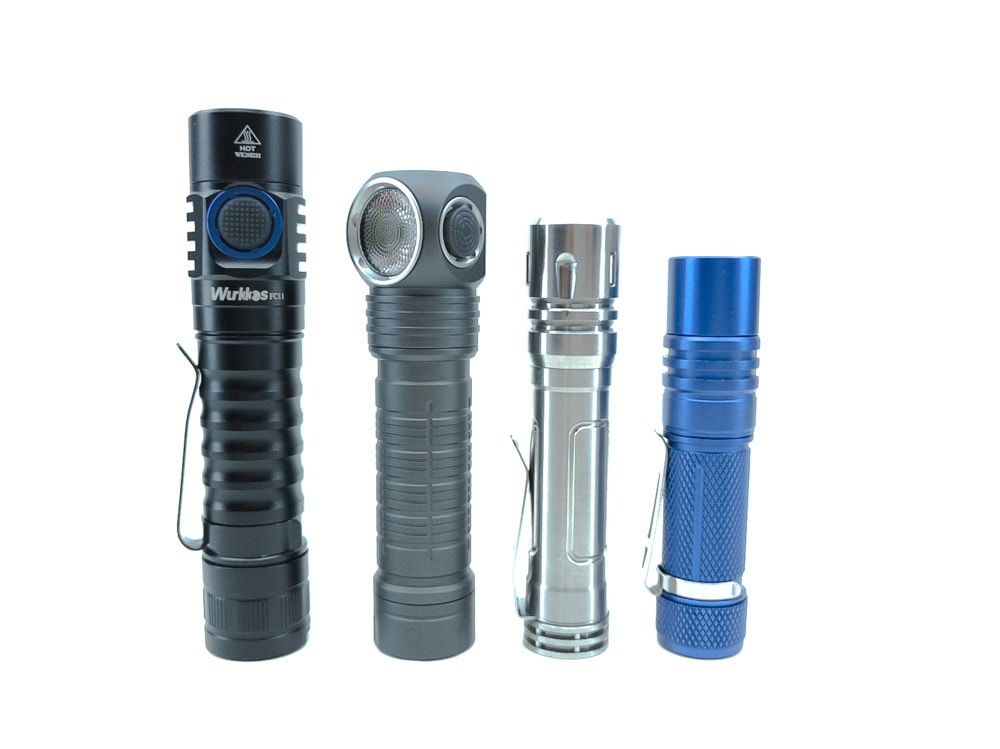
Driver & User Interface:
When doing an initial read-through of Skilhunt’s UI, it can look a bit intimidating at first. But then, if you’re like me, you realize that it’s pretty standard: click on/off, hold for low, and double click for turbo. It’s just that each mode gives you a couple options (two low modes and two turbo modes).
Available modes: L2, L1, M2, M1, H, T2, T1 (in increasing order)
From OFF:
- Press and Hold: turn on in last Low (L1 / L2) mode
- Single click: turn on in last Common (H / M1 / M2) mode
- Double click: turn on in last Turbo (T1 / T2) mode
- Triple click: turn on in Strobe (S1 / S2 / S3)
- 4x click: enter Lock-out mode
From ON:
- Press and Hold: switch between the available modes, so in Low mode it switches between L1 and L2 (only), Common mode switches between H, M2, and M1, while Turbo mode switches between T1 and T2
- Single click: turns off
- Double click: switch between Common and Turbo modes
- Triple click: switch between Common/Turbo and Strobe modes
Mode memory:
- Yes, every mode set (Low, Common, Turbo, and Strobes) have memory
Shortcuts:
- To Low: press and hold
- To Turbo: double click
- To Strobe: triple click
Low voltage warning:
- When voltage is getting low, the H300 will quickly blink once every two minutes
Strobe/blinkies
- There are three blinky modes: Strobe, SOS, and Beacon
- These can be accessed by a triple click from Off, Common, or Turbo modes (not Low though)
- Hold to move to the next blinky mode
- Triple click to return back to Common or Turbo modes
- Single click to turn off
Lock-out mode:
- From off, a 4x click will enable lock-out mode which will be confirmed by a double blink
- By default, a location indicator light behind the switch will start blinking. It can be disabled with a double click.
- A 4x click exits lock-out mode and goes directly to Low mode
PWM
- No PWM is present
Additional info on the UI:
- The LED in the switch serves as a power indicator
- When you turn the light on, it blinks:
- 4 blinks: 100-80%
- 3 blinks: 80-50%
- 2 blinks: 50-20%
- 1 blink: 20-0%
- When the battery drops below 3.0 volts, the indicator will begin to flash
Batteries & Charging
The Skilhunt H300 has three battery choices at purchase time: no battery, a 3100 mAh battery, or a 3500 mAh battery. Mine arrived with the 3100 mAh battery, a protected button-top cell. I also tried some unprotected flat-top batteries (Samsung 30Q and 35E) and those worked without any problems. The driver’s contact is a spring, and there’s a spring in the tailcap. So that affords a reasonable range of acceptable lengths.
The H300 has a magnetic charging port on the end of its head. The included Skilhunt MC-20 charging cable snaps firmly in place and charges at a purported 2 amp rate. At one point during the charge cycle, I observed 5.09 volts at 1.73 amps for 8.81 watts. The charge was completed in 2 hours and 5 minutes, transferring 11.76 Wh. The ending voltage was 4.09 volts. This is a bit lower than the typical 4.20 volts for lithium-ion batteries, but a nice safe voltage that may help extend the life of the cell.
I should also note that the Skilhunt H300 accepts 2x CR123A batteries, albeit at a lower output. With these primary batteries, output supposedly tops out at 1000 lumens.
Looking for some of the best flashlight batteries?
Read our guide: the best batteries for flashlights
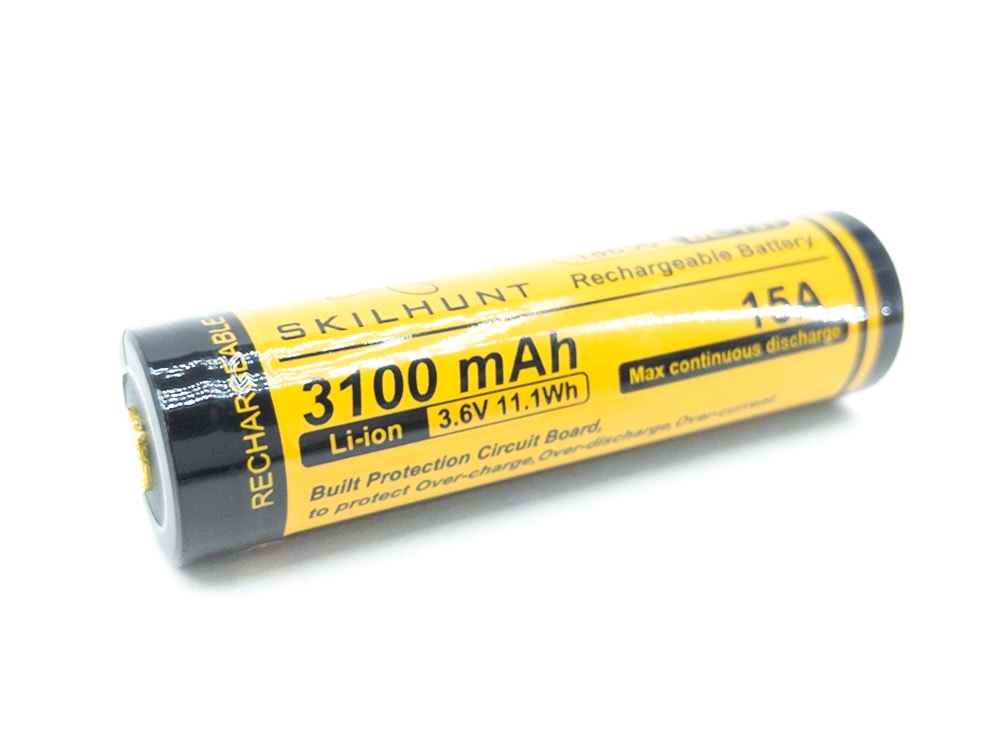
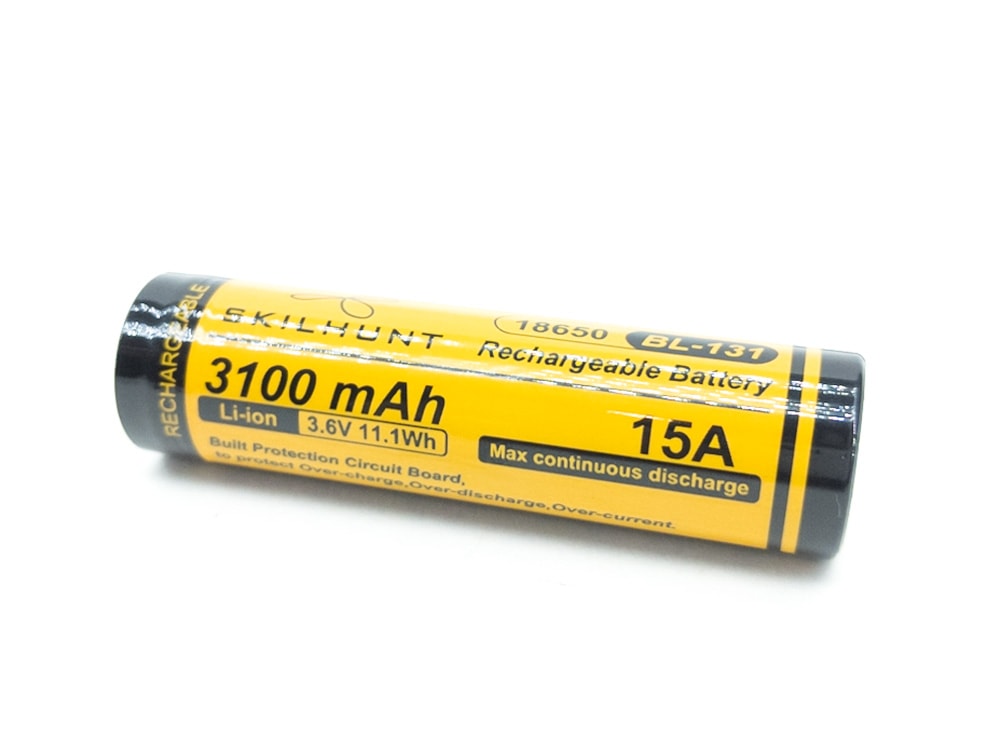
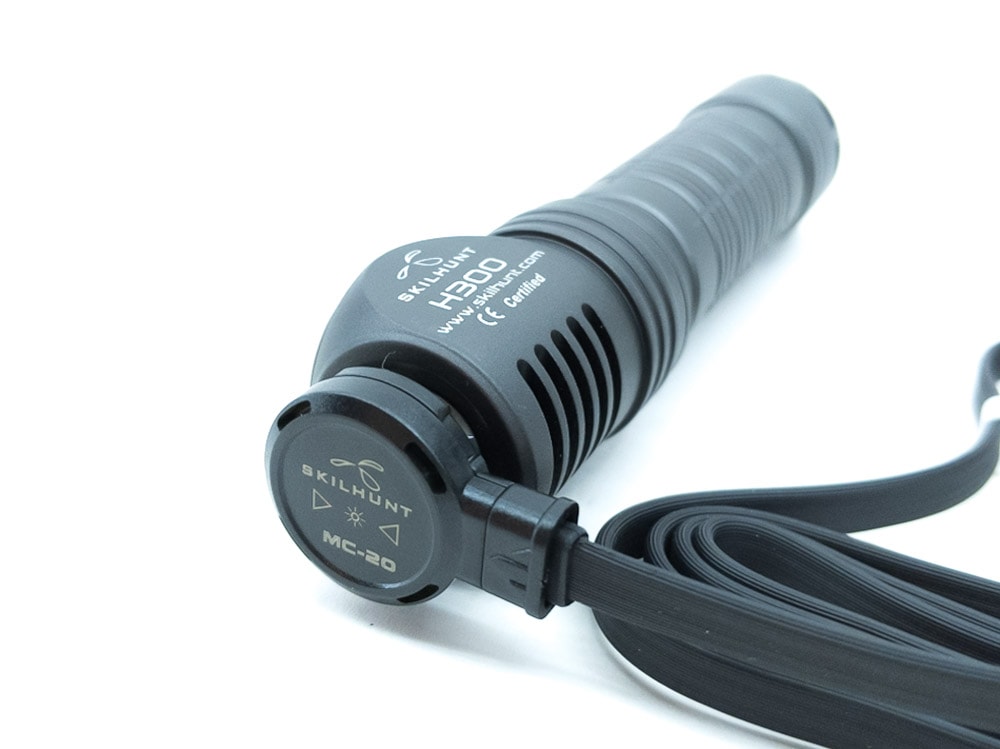
Performance
For current measurements, an ANENG AN8008 multimeter and UNI-T UT210E clamp meter were used. Lux was measured by a UNI-T UT383 BT at 5 meters. Lumens were measured in a homemade lumen tube using a TSL2591 sensor, calibrated with a Maukka calibration light. The temperature was monitored with a MLX90614 IR temperature sensor. The included Skilhunt 3100 mAh battery was used for testing.
Lumen measurements (for each mode)
| Mode | Amps at start | Specs (lm) | start | 30 sec | 10 min |
|---|---|---|---|---|---|
| Low 2 | 4 mA | 0.5 | 0.6 | – | – |
| Low 1 | 12 mA | 5 | 5.4 | – | – |
| Med 2 | 64 mA | 45 | 37 | – | – |
| Med 1 | 288 mA | 160 | 164 | 164 | 163 |
| High | 912 mA | 480 | 464 | 460 | 454 |
| Turbo 2 | 2.6 A | 1300 | 1252 | 1225 | 611 |
| Turbo 1 | 5.4 A | 2200* | 2238 lm | 2083 lm | 756 |
*Note: I’m not sure what’s going on with the Skilhunt H300’s specs. The box says 2500 lumens, but the manual inside says 2200 lumens. That latter figure lines up much closer to what I measured, so I’m going with it. One thing to note: the webpage for the H300 / H300R mentions 2500 lumens / 2200 lumens, so I’m guessing maybe one figure is for the reflector version (2500 lm) and the other is for the TIR version (2200 lm). That makes sense because optics always have a certain amount of lumen loss.
Parasitic drain:
- 44 µA
Runtime graph
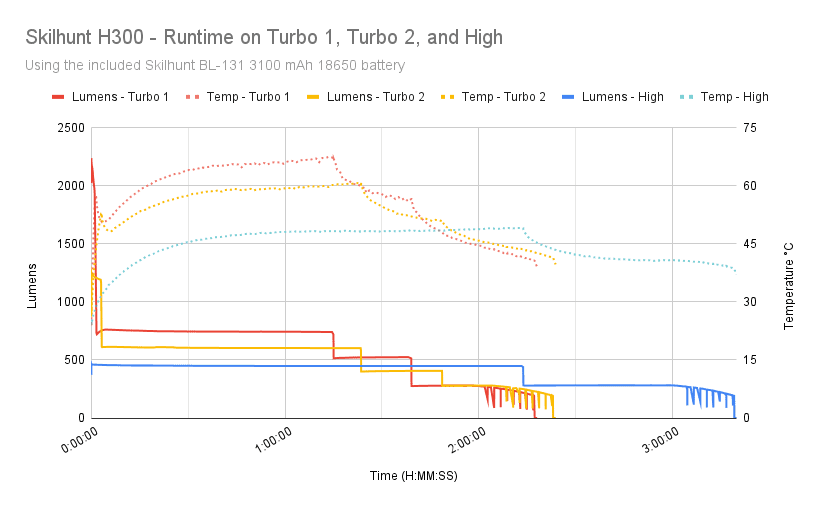
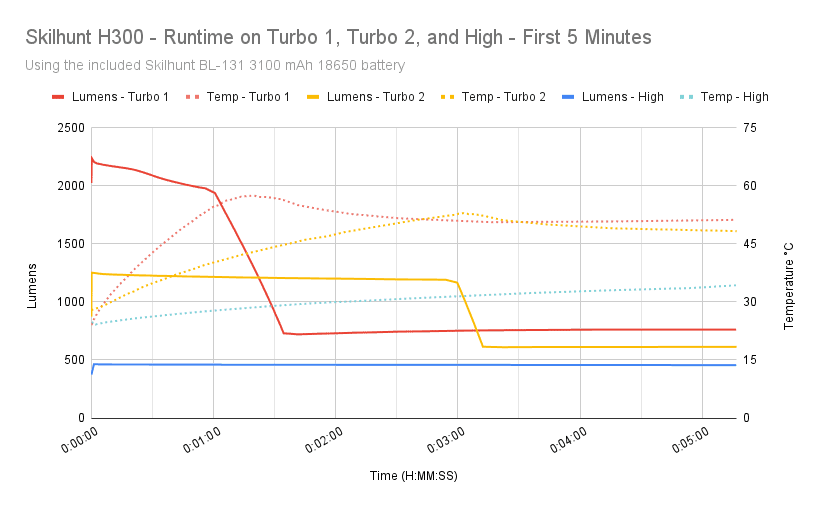
Turbo 1 (the brighter Turbo) started out at 2238 lumens and slowly dropped down to 1937 lumens at the 1 minute mark where it began a noticeable ramp down to 730 lumens 30 seconds later. Output stair-stepped down a bit later on as the battery began to deplete. At 2 hours and 2 minutes, low voltage warning blinks started to happen. The light shut off at 2 hours and 18 minutes. It hit a maximum temperature of 67.0°C.
In Turbo 2 (the less bright Turbo), the H300 started at 1252 lumens. At 3 minutes, it dropped down to 612 lumens. As the battery drained, it dropped down a couple more times. The low voltage warnings kicked in at 2 hours and 8 minutes. The light shut off at 2 hours and 23 minutes. The max temperature was 60.5°C.
High mode started out at 464 lumens. It stayed pretty consistent at that level until 2 hours and 13 minutes it dropped down to 279 lumens. At 3 hours and 4 minutes, low voltage blinks kicked in. The light shut off at 3 hours and 19 minutes. The max temperature was 48.8°C.
I ran a Medium 1 test which was pretty boring. It stayed around 163 lumens until the warnings happened at 7 hours and 15 minutes. The light shut off at 7 hours and 36 minutes.
My observed runtimes are shorter than what’s stated in the manual. I think there are two reasons for this. The first (and main) reason is that Skilhunt’s testing was done with their 3500 mAh battery, but my sample came with their 3100 mAh battery. That alone would have increased runtime around 13%. Secondly, you’d usually charge a battery to 4.20 volts before beginning a test. Skilhunt’s charger stopped at 4.09 volts; it could have put a bit more charge into the battery which would have resulted in some additional runtime.
Throw numbers:
For the throw measurements, I tested the H300 at 5 meters using my UNI-T UT383 BT.
| Mode | Specs | Candela measured | Meters | Yards |
|---|---|---|---|---|
| High | – | 1,625 cd | 81 | 89 |
| Turbo 2 | – | 4,450 cd | 133 | 145 |
| Turbo 1 | 5,000 cd* | 8,150 cd | 180 | 197 |
*Note: the manual states that the reflector version, the H300R, has 5500 cd
Beamshots
Beam shots of the building are taken at 15 m (16 yd) using a Pixel 3 set to ISO 200 with 1/10 second exposure time
Beam shots of the playset are taken at 30 m (33 yd) using a Pixel 3 set to ISO 200 with 1/2 second exposure time. The trees in the background are around 65 m away.
- Skilhunt H300
- Nitecore HC60 V2
- Wuben H1
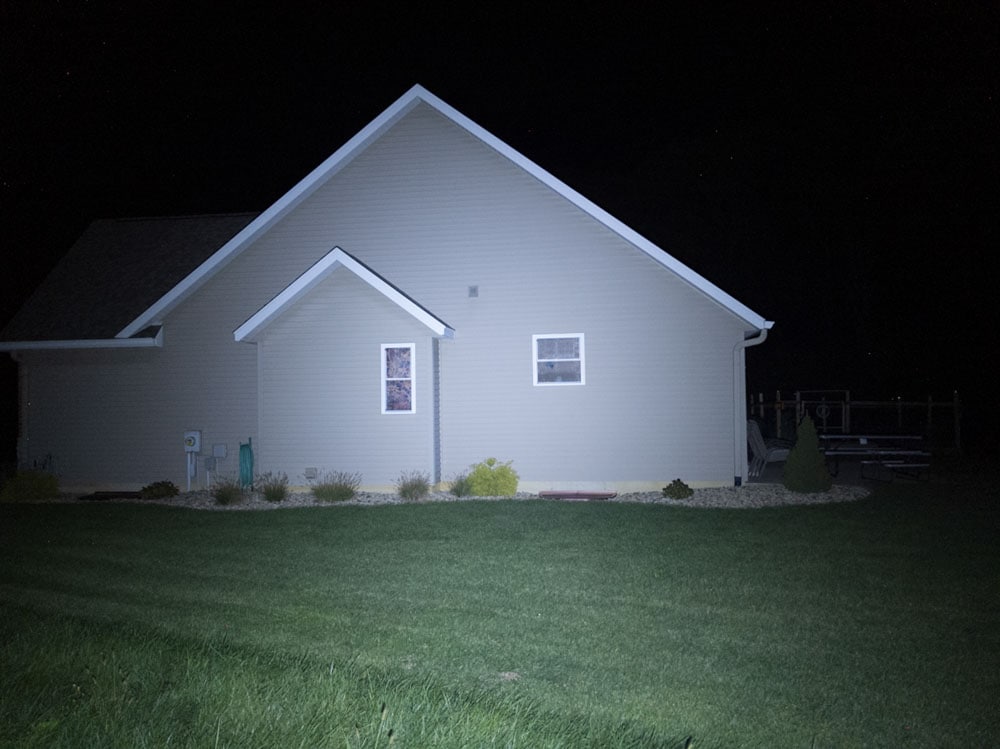
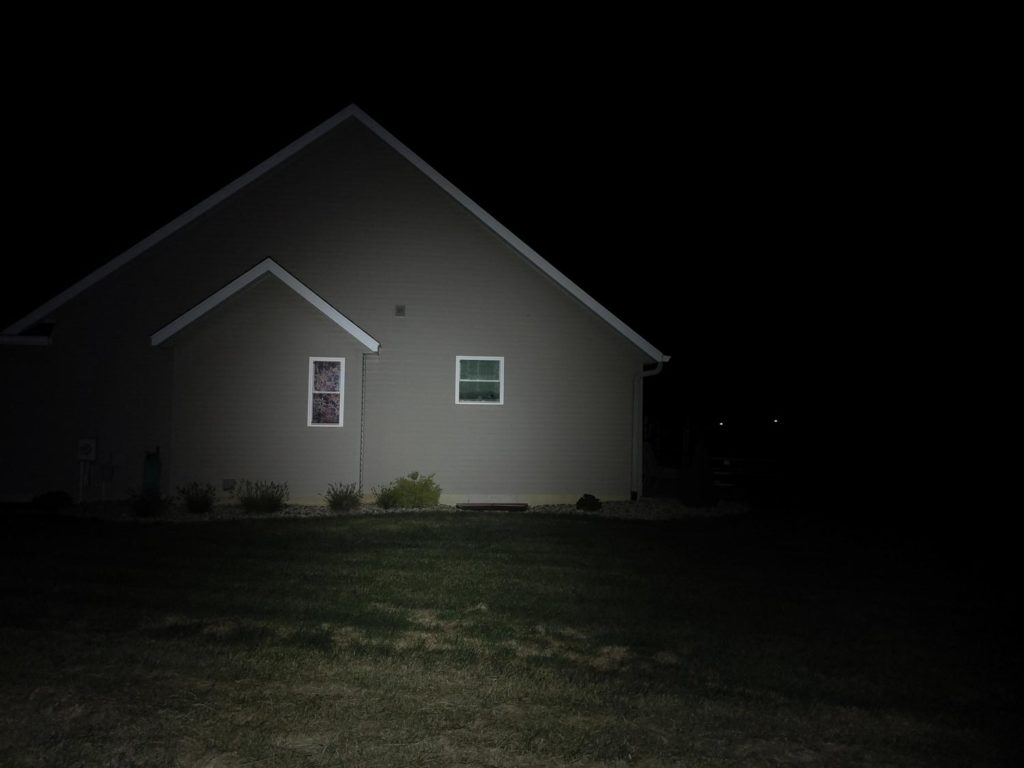
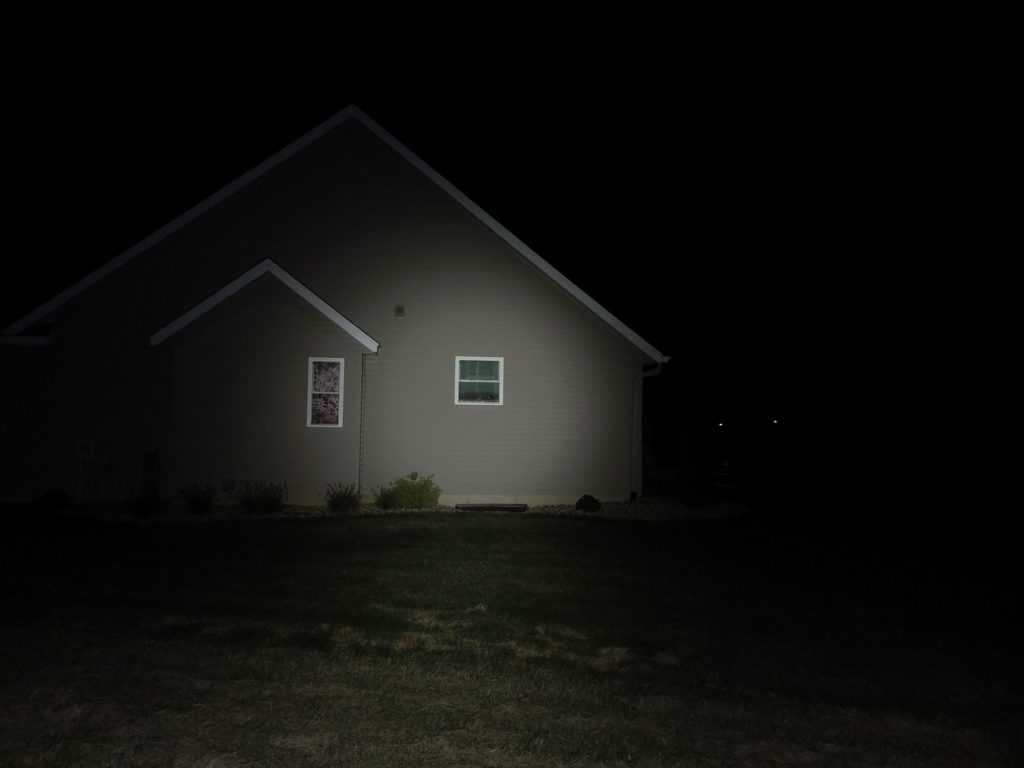



Disclaimer: This flashlight was sent to me for review at no cost by Skilhunt. I have not been paid to review, nor have I been holding back on problems or defects.
Final Verdict
Pros
- Great build quality
- Beautiful design & optic
- Well regulated output
- Magnetic charging
- Battery flexibility
- Very nice UI
- Sub-lumen mode
Cons
- Cool White LED (note: NW available)
Explanation on star ratings:
1: Avoid: my phone flashlight would be a better choice – 2: Poor: significant defect or issues, much better options available at the same price – 3: Average: some defects or issues – 4: Good: recommended (minor issues) – 5: Great: highly recommended

5 stars: ★★★★★
Now I see why the older Skilhunt models H03 and H04 were so popular. Skilhunt really knows how to build a headlamp. The regulation, modes, and UI are very nice. The build quality is flawless. In all honesty, I’m finding it difficult to complain about anything with this Skilhunt H300 – it’s such a great, all around headlamp. It’s beautiful, it’s functional, and it comes with all the goodies that you need. The Skilhunt H300 will be my go-to headlamp for the foreseeable future.
Buy your Skilhunt H300 here:
The link below is to the newest version of the Skilhunt H300.
Get 6% discount at Skilhunt by using the following discount code: blf06
1lumen selects and reviews products personally. We may earn affiliate commissions through our links, which help support our testing.